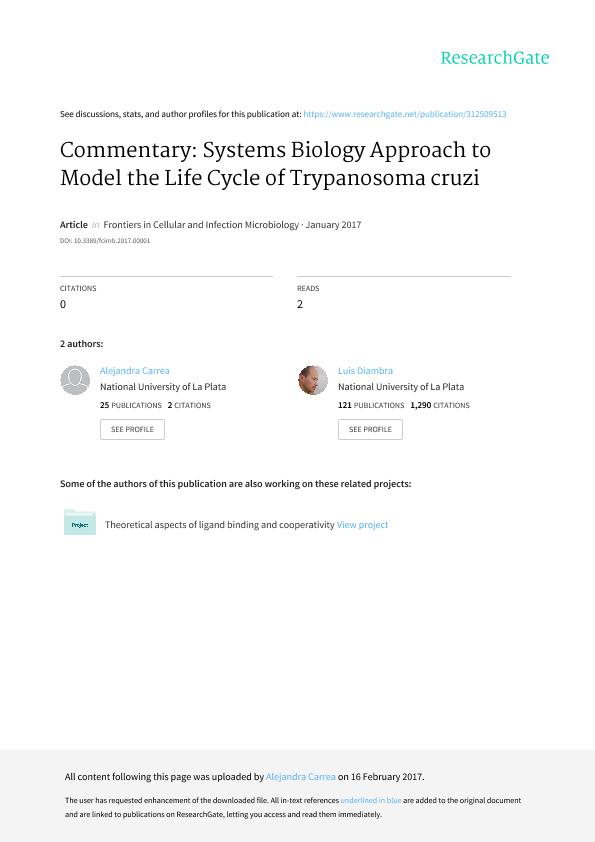Mostrar el registro sencillo del ítem
dc.contributor.author
Carrea, Alejandra

dc.contributor.author
Diambra, Luis Anibal

dc.date.available
2018-08-15T19:57:19Z
dc.date.issued
2017-01
dc.identifier.citation
Carrea, Alejandra; Diambra, Luis Anibal; Commentary: Systems biology approach to model the life cycle of Trypanosoma cruzi; Frontiers Research Foundation; Frontiers in Cellular and Infection Microbiology; 7; JAN; 1-2017; 1-3
dc.identifier.issn
2235-2988
dc.identifier.uri
http://hdl.handle.net/11336/55742
dc.description.abstract
In a recent work we have identified, from a bigger gene regulatory network, a seven-node moduleinvolved in the control of the life cycle of Trypanosoma cruzi (T. cruzi) (Carrea and Diambra,2016). To that end, we have analyzed microarray gene-expression data of the four differentT. cruzi?s life cycle stages, by means of a systems biology approach. The found module is thesmallest gene regulatory subnetwork able to emulate the dynamical properties of the parasite.This module is composed of nine genes: three of them coding for uncharacterized proteins, andthe other six genes coding for characterized proteins. The latter code for: a hexokinase, a δ-1-pyrroline-5-carboxylate dehydrogenase, a quinone oxidoreductase, a glutamate dehydrogenase, apeptidyl-prolyl cis-trans isomerase, and a metaciclina II. Except for metaciclina II, these genes codefor proteins involved in metabolic pathways. Thus, we were expecting gene-expression regulatoryproteins instead of the striking information we obtained. Yet, it eventually became clear that thesemetabolic enzymes could have other regulatory functions beyond their known metabolic one. Thistype of multifunctional proteins are known as moonlighting proteins (Jeffery, 1999). They were firstdiscovered in the late 1980s by Piatigorsky et al. (1988). They found that the lens structural proteinδ-crystallin and the metabolic enzyme argininosuccinate lyase are both encoded by the same gene inducks. Today, it is well-known that moonlighting proteins comprise diverse kinds of proteins, andthat they are present in many different organisms including animals, plants, yeasts, prokaryotes,and protists (for reviews see Jeffery, 2009; Huberts and van der Klei, 2010; Jeffery, 2014).
dc.format
application/pdf
dc.language.iso
eng
dc.publisher
Frontiers Research Foundation

dc.rights
info:eu-repo/semantics/openAccess
dc.rights.uri
https://creativecommons.org/licenses/by-nc-sa/2.5/ar/
dc.subject
Computational Approaches
dc.subject
Gene Regulatory Network
dc.subject
Metabolic Enzymes
dc.subject
Moonlighting Proteins
dc.subject
Trypanosoma Cruzi
dc.subject.classification
Otras Ciencias Biológicas

dc.subject.classification
Ciencias Biológicas

dc.subject.classification
CIENCIAS NATURALES Y EXACTAS

dc.title
Commentary: Systems biology approach to model the life cycle of Trypanosoma cruzi
dc.type
info:eu-repo/semantics/article
dc.type
info:ar-repo/semantics/artículo
dc.type
info:eu-repo/semantics/publishedVersion
dc.date.updated
2018-08-13T14:47:19Z
dc.journal.volume
7
dc.journal.number
JAN
dc.journal.pagination
1-3
dc.journal.pais
Suiza

dc.description.fil
Fil: Carrea, Alejandra. Universidad Nacional de La Plata. Centro Regional de Estudios Genómicos; Argentina. Consejo Nacional de Investigaciones Científicas y Técnicas; Argentina
dc.description.fil
Fil: Diambra, Luis Anibal. Universidad Nacional de La Plata. Centro Regional de Estudios Genómicos; Argentina. Consejo Nacional de Investigaciones Científicas y Técnicas; Argentina
dc.journal.title
Frontiers in Cellular and Infection Microbiology
dc.relation.alternativeid
info:eu-repo/semantics/altIdentifier/doi/http://dx.doi.org/10.3389/fcimb.2017.00001
dc.relation.alternativeid
info:eu-repo/semantics/altIdentifier/url/https://www.frontiersin.org/articles/10.3389/fcimb.2017.00001/full
Archivos asociados
